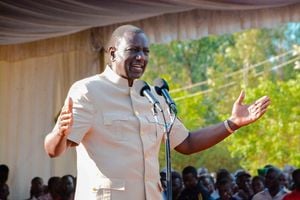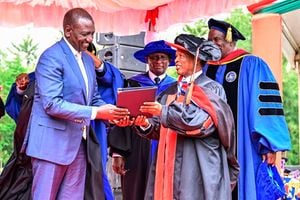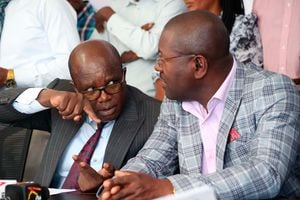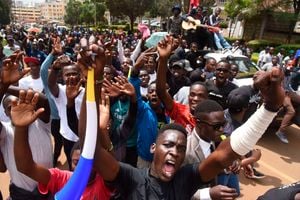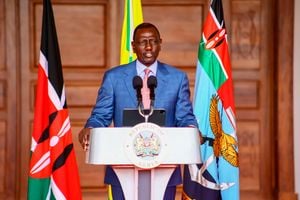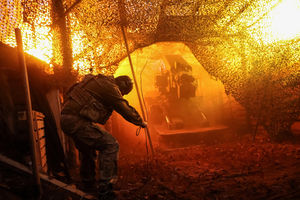
A student from University students displays a placard during protests against the new university funding model in Kesses, Uasin Gishu County on September 09, 2024.
The 129-member committee appointed by President William Ruto on Monday to review the higher education funding model has run into headwinds even before it starts working.
University students have protested the composition of the committee, questioning the criteria used to appoint its membership. Some stakeholders
It has now emerged that the majority of the committee members are university students but some universities lack representation in the committee, sparking accusations of favouritism.
A number of the students in the committee are also political activists associated with the United Democratic Alliance (UDA), while one is a dropout who works with a politician.
On Monday, President Ruto announced the formation of the National Working Committee on Review of the New University Education Funding Model, through a special Kenya Gazette notice following growing concerns from students and parents about the model's fairness and effectiveness.
A section of students now argue that the selection process for the committee was not transparent and that it might not achieve the intended objectives. There are concerns around the qualifications of some of the individuals, with accusations that the selection was influenced by political affiliations.
Among university that lack representation are south eastern university, Pwani university, TUM, Masinde Muliro, University of Eldoret, South Eastern Kenya University, Kibabii, Kisii University, Cooperative University of Kenya.
“We are trying to solve something but they keep making the same mistakes. There are no universities that are superior to others. This university is home to a significant student population, none of its leaders or students were included in the committee. This is favouritism towards universities such as the University of Nairobi, Kenyatta University, Jomo Kenyatta University of Agriculture and Technology, and the Technical University of Kenya, leaving many questioning the fairness of the selection process,” said Remmy Osoti, the president of the students union of the Multi Media University of Kenya.
The Nation has learned that the students appointed in the committee were called for confirmation of their official names and then added to a WhatsApp group. They later found their names in gazette notice signed by the President.
“If the government is truly broad-based, why isn't the committee equally inclusive? Our commitment to the talks remains strong, but real progress demands transparency and broader representation, not secretive meetings that undermine our values of openness and inclusivity,” said a student leader.
Carlos Abich, the secretary-general of Mount Kenya University Student Association also claimed that one of the members of the committee is no longer a student in any university.
“How can we justify selecting someone who dropped out of university and now aligns with politicians to influence decisions on student funding? Where is the transparency and authenticity in this process? We want to know the criteria that they used.”
Allan Ochieng, the president of the students’ union at Masinde Muliro University of Science and Technology (MMUST), voiced frustration over the absence of representation for universities in Western Kenya.
“We still haven’t received any details about the selection criteria. This situation challenges the legitimacy of their decisions. Now, every student in Western Kenya is waiting to see how universities with more representation will respond. This is a grave injustice,” said Mr Ochieng.
Elvis Owino, the president of the Technical University of Mombasa, condemned the lack of transparency, highlighting the need for an explanation of when and how the selection was conducted.
“I’m unaware of how the committee was formed; many of us learned about it the same way others did — through the media. If you analyze the situation, you'll see that universities that participated in the September 9th protests have been excluded. For instance, the University of Nairobi (UON) and Kenyatta University (KU) were affected. The UON president mentioned the planned demonstration, but the secretary-general issued a memo prohibiting it. What are their intentions, and what are they trying to achieve with these actions?,” posed Mr Owino.
Further fueling the controversy, Vincent Obondo, students’ union president at Pwani University, decried the underrepresentation of the Coast region.
“It’s unacceptable that out of the 129-member committee, only one person is from the Coast region. We reject this committee and will continue to protest, despite their efforts to undermine us,” said Mr Obondo.
There are also allegations that some were students were paid to call off the planned strike a week ago.
“Many of those selected met with the ministry and were given handouts. This undermines transparency and suggests a troubling influence over student advocacy. How can such practices be justified when they directly affect the credibility of both the appointments and the broader funding model?” one student questioned.

